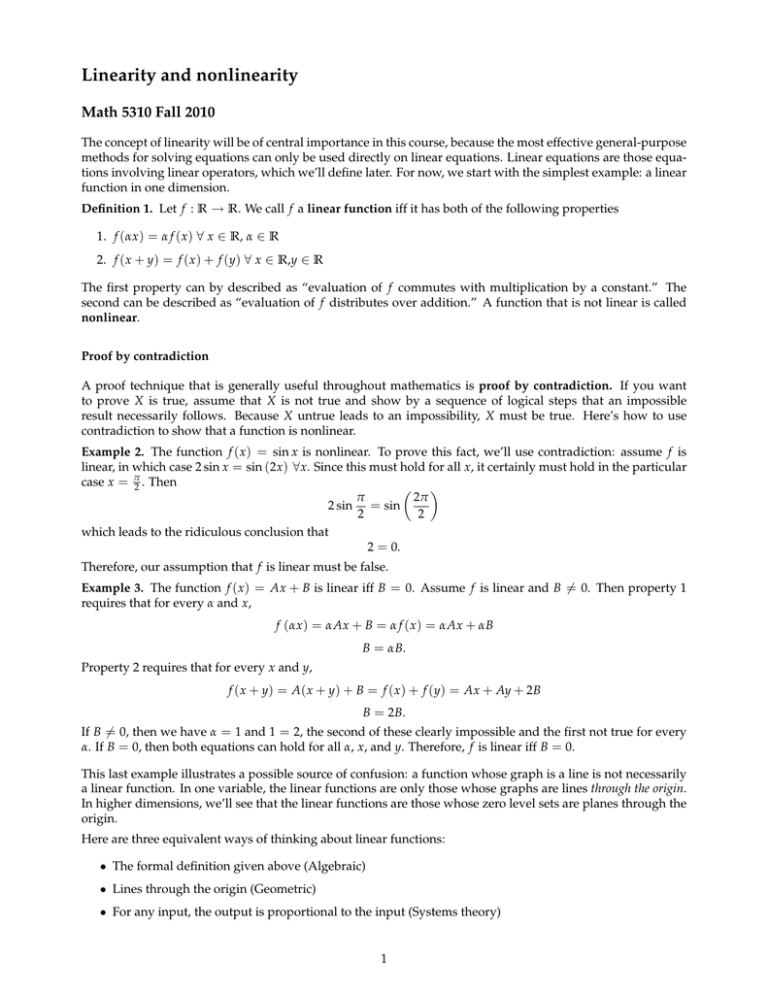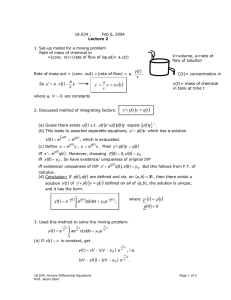Linearity and nonlinearity
advertisement

Linearity and nonlinearity Math 5310 Fall 2010 The concept of linearity will be of central importance in this course, because the most effective general-purpose methods for solving equations can only be used directly on linear equations. Linear equations are those equations involving linear operators, which we’ll define later. For now, we start with the simplest example: a linear function in one dimension. Definition 1. Let f : R → R. We call f a linear function iff it has both of the following properties 1. f (αx ) = α f ( x ) ∀ x ∈ R, α ∈ R 2. f ( x + y) = f ( x ) + f (y) ∀ x ∈ R,y ∈ R The first property can by described as “evaluation of f commutes with multiplication by a constant.” The second can be described as “evaluation of f distributes over addition.” A function that is not linear is called nonlinear. Proof by contradiction A proof technique that is generally useful throughout mathematics is proof by contradiction. If you want to prove X is true, assume that X is not true and show by a sequence of logical steps that an impossible result necessarily follows. Because X untrue leads to an impossibility, X must be true. Here’s how to use contradiction to show that a function is nonlinear. Example 2. The function f ( x ) = sin x is nonlinear. To prove this fact, we’ll use contradiction: assume f is linear, in which case 2 sin x = sin (2x ) ∀ x. Since this must hold for all x, it certainly must hold in the particular case x = π2 . Then π 2π 2 sin = sin 2 2 which leads to the ridiculous conclusion that 2 = 0. Therefore, our assumption that f is linear must be false. Example 3. The function f ( x ) = Ax + B is linear iff B = 0. Assume f is linear and B 6= 0. Then property 1 requires that for every α and x, f (αx ) = αAx + B = α f ( x ) = αAx + αB B = αB. Property 2 requires that for every x and y, f ( x + y) = A( x + y) + B = f ( x ) + f (y) = Ax + Ay + 2B B = 2B. If B 6= 0, then we have α = 1 and 1 = 2, the second of these clearly impossible and the first not true for every α. If B = 0, then both equations can hold for all α, x, and y. Therefore, f is linear iff B = 0. This last example illustrates a possible source of confusion: a function whose graph is a line is not necessarily a linear function. In one variable, the linear functions are only those whose graphs are lines through the origin. In higher dimensions, we’ll see that the linear functions are those whose zero level sets are planes through the origin. Here are three equivalent ways of thinking about linear functions: • The formal definition given above (Algebraic) • Lines through the origin (Geometric) • For any input, the output is proportional to the input (Systems theory) 1
